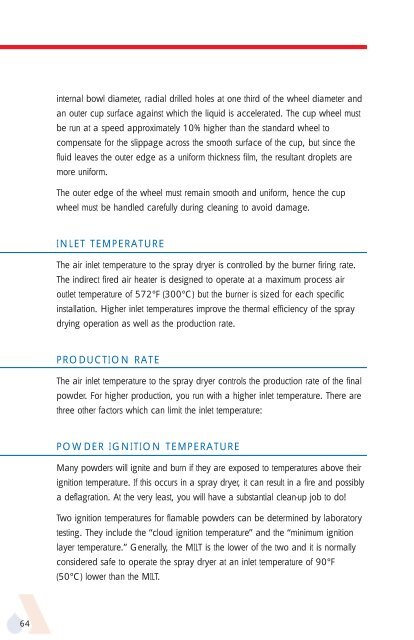APV Dryer Handbook - Umbc
APV Dryer Handbook - Umbc
APV Dryer Handbook - Umbc
Create successful ePaper yourself
Turn your PDF publications into a flip-book with our unique Google optimized e-Paper software.
64<br />
internal bowl diameter, radial drilled holes at one third of the wheel diameter and<br />
an outer cup surface against which the liquid is accelerated. The cup wheel must<br />
be run at a speed approximately 10% higher than the standard wheel to<br />
compensate for the slippage across the smooth surface of the cup, but since the<br />
fluid leaves the outer edge as a uniform thickness film, the resultant droplets are<br />
more uniform.<br />
The outer edge of the wheel must remain smooth and uniform, hence the cup<br />
wheel must be handled carefully during cleaning to avoid damage.<br />
INLET TEMPERATURE<br />
The air inlet temperature to the spray dryer is controlled by the burner firing rate.<br />
The indirect fired air heater is designed to operate at a maximum process air<br />
outlet temperature of 572°F (300°C) but the burner is sized for each specific<br />
installation. Higher inlet temperatures improve the thermal efficiency of the spray<br />
drying operation as well as the production rate.<br />
PRODUCTION RATE<br />
The air inlet temperature to the spray dryer controls the production rate of the final<br />
powder. For higher production, you run with a higher inlet temperature. There are<br />
three other factors which can limit the inlet temperature:<br />
POWDER IGNITION TEMPERATURE<br />
Many powders will ignite and burn if they are exposed to temperatures above their<br />
ignition temperature. If this occurs in a spray dryer, it can result in a fire and possibly<br />
a deflagration. At the very least, you will have a substantial clean-up job to do!<br />
Two ignition temperatures for flamable powders can be determined by laboratory<br />
testing. They include the “cloud ignition temperature” and the “minimum ignition<br />
layer temperature.” Generally, the MILT is the lower of the two and it is normally<br />
considered safe to operate the spray dryer at an inlet temperature of 90°F<br />
(50°C) lower than the MILT.











